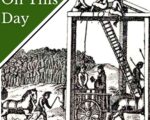
On this day in Tudor history, 7th March 1544, in the reign of King Henry VIII, Germaine (or German) Gardiner and priest John Larke were executed for denying the royal supremacy.
[Read More...]
On this day in Tudor history, 7th March 1544, in the reign of King Henry VIII, Germaine (or German) Gardiner and priest John Larke were executed for denying the royal supremacy.
[Read More...]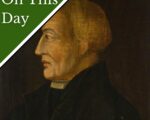
During the night of 28th February/1st March 1551, theologian and Protestant reformer Martin Bucer died in Cambridge. He was fifty-nine years old.
Let me tell tell you a bit more about this reformer, who ended up being posthumously burned as a heretic in Mary I’s reign!
[Read More...]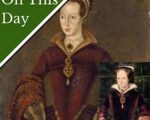
This day in Tudor history, 9th February 1554, in the reign of Queen Mary I, was one of the dates set for the execution of Lady Jane Grey, the former Queen Jane, but she was granted a three-day reprieve.
Why and what had happened between her trial in November 1553, when she had been condemned to death, and this day?
Let me tell you…
[Read More...]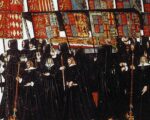
People all over the world have tuned in to watch the funeral of Queen Elizabeth II today, a queen who reigned for over 70 years and who was descended from Margaret Tudor, Queen of Scotland, and, therefore, King Henry VII, as well as having Boleyn blood.
The funeral procession and ceremony were full of tradition and ritual, and our Tudor ancestors would recognise much of it, so I thought I’d share with you some information on Tudor royal funerals.
[Read More...]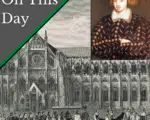
On this day in Tudor history, 1st June 1593, the inquest into the death of playwright, poet and translator Christopher Marlowe took place.
Twenty-nine-year-old Marlowe, writer of such famous works as “Tamburlaine”, “Dr Faustus” and “The Jew of Malta”, had been fatally stabbed at a house in Deptford Strand, London, by a man named Ingram Frizer on 30th May 1593, but what happened?
[Read More...]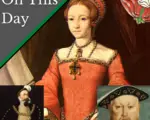
On this day in Tudor history, 23rd May 1554, Elizabeth, daughter of King Henry VIII and his second wife, Anne Boleyn, arrived at the Palace of Woodstock in Oxfordshire, where she was placed under house arrest.
Elizabeth remained under house arrest there for just under a year, and she didn’t make it easy for her gaoler, Sir Henry Bedingfield, and neither did her servants.
Find out why Elizabeth was under house arrest and what happened…
[Read More...]
On this day in Tudor history, 13th November 1536, mercer and member of Parliament Robert Packington (Pakington, Pakyngton) was shot to death by an unknown assailant while he was on his way to mass at St Thomas of Acre Chapel. He was shot with a wheellock pistol.
Robert Packington has gone down in history as the first person in England to be killed by a handgun, but who killed him and why?
Find out about Packington, his murder, and the theories regarding who ordered his murder, in this talk…
[Read More...]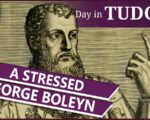
On this day in Tudor history, 11th November 1534, Philippe de Chabot, Seigneur De Brion and Admiral of France, landed on English soil. The purpose of the diplomatic mission he was leading was to renew Anglo-French relations.
George Boleyn, Lord Rochford, brother of Queen Anne Boleyn, had been put in charge of meeting the admiral and escorting him on his journey from the south coast to London, but it was no easy task. The admiral did not make things easy at all, and George was rather stressed about the situation.
Find out what happened, and how and why the ambassador’s visit was bad news all round for the Boleyns, in this talk…
[Read More...]
On this day in Tudor history, 7th November 1485, Henry VII’s first parliament attainted King Richard III and his supporters.
As well as Richard, who was referred to as Richard, late Duke of Gloucester, and a usurper, the list of those attainted for their treason in fighting against the king at Bosworth included the late John Howard, 1st Duke of Norfolk, and his son, the Earl of Surrey.
Find out who else was included and whether Parliament’s actions were unusual, in this talk…
[Read More...]
On this day in history, 2nd November 1470, the feast of All Souls, King Edward V was born at Westminster Abbey, London. Young Edward was King of England for just 2 months in 1483 before he disappeared.
The events of his short life, his short reign and how it ended, are linked to the Tudors because Henry Tudor returned from exile to challenge King Richard III, who had, of course, taken the throne from Edward V.
Find out about Edward V’s life and how he came to be one of the famous Princes in the Tower, in this talk…
[Read More...]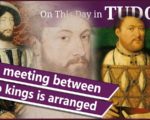
On this day in Tudor history, 16th October 1532, while Henry VIII and Anne Boleyn, Marquess of Pembroke, were on their visit to Calais, English nobles met French nobles to arrange a meeting between the King of England and his French counterpart, King Francis I.
In this video, I give details on this event, who was there, what happened, and why Henry VIII and Anne Boleyn had gone to Calais…
[Read More...]
n this day in Tudor history, Saturday 10th September 1547, in the reign of King Edward VI, the Battle of Pinkie Cleugh, also known as the Battle of Pinkie, took place near Musselburgh, in Scotland, on the banks of the River Esk. The English forces, led by Edward Seymour, Duke of Somerset, defeated the Scots, killing thousands.
It was a bloody battle, but started off well for the Scots. In this video, I share an eye-witness account of how the battle changed so dramatically, leading to the loss of between 6,000 and 15,000 Scots.
[Read More...]
On this day in Tudor history, 8th August 1503, King Henry VII’s eldest daughter, Margaret Tudor, married King James IV of Scotland.
Find out more about their marriage, and how it was arranged, in this edition of #TudorHistoryShorts…
[Read More...]
On this day in Tudor history, 2nd July 1594, a sexton and gravedigger known as Old Scarlett was buried at Peterborough Cathedral.
Who was this man? Which two queens was he said to have buried? And what is his link to Shakespeare?
Find out more about Old Scarlett in this edition of #TudorHistoryShorts…
[Read More...]
On this day in Tudor history, 23rd May 1547, in the reign of King Edward VI, Henry Grey, 3rd Marquis of Dorset, was finally installed as a Knight of the Garter.
Grey had wanted this honour for years and had been nominated many times, so what had changed? How did he end up joining the Order of the Garter.
Find out in this video…
[Read More...]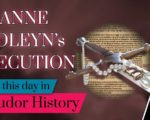
On this day in Tudor history, 19th May 1536, Henry VIII’s second wife, Queen Anne Boleyn, was executed at the Tower of London.
Find out more, and hear some of her final words, in this #TudorHistoryShorts video…
[Read More...]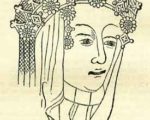
On this day in history, 3rd May 1415, a woman who was the matriarch of the House of York and mother of two kings, was born. Her name was Cecily Neville.
Find out about this Duchess of York, and how she is linked to royalty and the Tudors, in this #TudorHistoryShorts video…
[Read More...]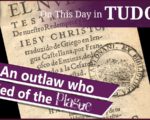
On this day in Tudor history, 30th December 1552, in the reign of King Edward VI, Spanish humanist scholar, translator, author and Protestant apologist, Francisco de Enzinas died at Strasbourg from the plague. He was buried there the next day. Humanist Francisco had changed his name to Francis Dryander after leaving Spain to study at Louvain.
Dryander fit a lot into his thirty-four years of life. He escaped from prison and was an outlaw, he translated the Bible, he taught Greek in England, he was supported by Archbishop Cranmer and the Duchess of Suffolk, and published several works.
Find out more about the accomplished Francis Dryander in today’s talk.
[Read More...]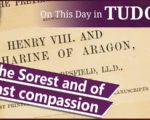
On this day in Tudor history, 18th December 1575,in the reign of Queen Elizabeth I, fifty-six-year-old historian, Catholic apologist, priest and former Archdeacon of Canterbury, Nicholas Harpsfield, died in London.
Harpsfield and his brother, John, had been imprisoned since the early 1560s for refusing to swear the Oath of Supremacy, but had been released in 1574 on the grounds of ill-health.
In Mary I’s reign, he had been involved in the persecutions of Protestants, and martyrologist John Foxe described him as “the sorest and of leaste compassion” of all the archdeacons involved.
Find out more about his life, career and rise, his works, and his end, in today’s talk.
[Read More...]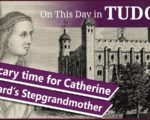
On this day in Tudor history, 9th December 1541, sixty-four-year-old Agnes Tilney, the Dowager Duchess of Norfolk and step-grandmother of Queen Catherine Howard, who was being detained at the Lord Chancellor’s home, was questioned regarding the location of her money and jewels.
Why? What was all this about?
Find out about this, why the dowager duchess ended up in the Tower, and what happened when she was indicted for misprision of treason, in today’s talk.
[Read More...]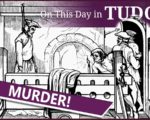
On this day in Tudor history, 4th December 1514, merchant tailor and leading member of the Lollard community in London, Richard Hunne died while imprisoned in the Lollard’s Tower at St Paul’s.
Hunne, who had been arrested for heresy in October 1514, was discovered hanging from the ceiling of his cell. The Bishop of London and his chancellor claimed that Hunne had used his own silk girdle to commit suicide, but a coroner’s inquest ruled that the hanging was faked and that Hunne was murdered.
But why was Richard Hunne murdered? And why had this merchant tailor been arrested in the first place? Was it just for heresy, or was there more to it?
Find out all about Hunne, his arrest, the charges against him, his death and what happened next, in today’s talk.
[Read More...]
On this day in Tudor history, 21st November 1495, churchman, Protestant playwright, historian and Bishop of Ossory, John Bale was born in Suffolk.
Bale wrote twenty-four plays, and a book on famous British writers, which is his most well-known work. His work on Protestant martyrs was also used by the famous martyrologist John Foxe.
John Bale also courted controversy with his attacks on Catholics, and he spent a fair amount of time in exile.
Find out all about this accomplished Tudor man in today’s talk.
[Read More...]
On this day in Tudor history, 13th November 1536, mercer and member of Parliament Robert Packington (Pakington, Pakyngton) was shot to death by an unknown assailant while he was on his way to mass at St Thomas of Acre Chapel. He was shot with a wheellock pistol.
Robert Packington has gone down in history as the first person in England to be killed by a handgun, but who killed him and why?
Find out about Packington, his murder, and the theories regarding who ordered his murder, in today’s talk.
[Read More...]
On this day in Tudor history, 12th November 1555, Mary I’s Lord Chancellor, Stephen Gardiner, Bishop of Winchester, died. He was laid to rest at Winchester Cathedral in what is now known as the Bishop Gardiner Chantry Chapel.
In today’s talk, I tell you about the life and career of “Wily Winchester”, a man who went from being a valued advisor to being imprisoned, and then got back into favour, crowned a queen and became Lord Chancellor! He led quite a life!
[Read More...]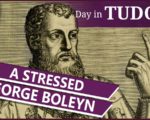
On this day in Tudor history, 11th November 1534, Philippe de Chabot, Seigneur De Brion and Admiral of France, landed on English soil. The purpose of the diplomatic mission he was leading was to renew Anglo-French relations.
George Boleyn, Lord Rochford, brother of Queen Anne Boleyn, had been put in charge of meeting the admiral and escorting him on his journey from the south coast to London, but it was no easy task. The admiral did not make things easy at all, and George was rather stressed about the situation.
Find out what happened, and how and why the ambassador’s visit was bad news all round for the Boleyns, in today’s talk.
[Read More...]
On this day in Tudor history, 7th November 1485, Henry VII’s first parliament attainted King Richard III and his supporters.
As well as Richard, who was referred to as Richard, late Duke of Gloucester, and a usurper, the list of those attainted for their treason in fighting against the king at Bosworth included the late John Howard, 1st Duke of Norfolk, and his son, the Earl of Surrey.
Find out who else was included and whether Parliament’s actions were unusual, in today’s talk.
[Read More...]
On this day in history, 2nd November 1470, the feast of All Souls, King Edward V was born at Westminster Abbey, London. Young Edward was King of England for just 2 months in 1483 before he disappeared.
The events of his short life, his short reign and how it ended, are linked to the Tudors because Henry Tudor returned from exile to challenge King Richard III, who had, of course, taken the throne from Edward V.
Find out about Edward V’s life and how he came to be one of the famous Princes in the Tower, in today’s talk. I even share who I think was responsible for the deaths of the Princes in the Tower.
[Read More...]
On this day in Tudor history, 16th October 1532, while Henry VIII and Anne Boleyn, Marquess of Pembroke, were on their visit to Calais, English nobles met French nobles to arrange a meeting between the King of England and his French counterpart, King Francis I.
In today’s talk, I give details on this event, who was there, what happened, and why Henry VIII and Anne Boleyn had gone to Calais.
[Read More...]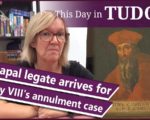
On this day in Tudor history, 29th September 1528, the papal legate, Cardinal Lorenzo Campeggio, landed at Dover on the Kent coast.
Campeggio and Cardinal Thomas Wolsey, who had been appointed the pope’s vice-regent, were given the task of hearing Henry VIII’s case for an annulment of his marriage to Catherine of Aragon.
Find out more about what happened when next, what happened at the special legatine court, and how Henry ended up waiting for his annulment for a few more years, in today’s talk.
[Read More...]
On this day in Tudor history, 21st September 1557, Henry Pendleton, theologian, chaplain and friend of Bishop Bonner, was buried at St Stephen’s, Walbrook, London.
Pendleton is known not only for his strong preaching, which led to him being shot at once, but also for his changing religious faith. He went from staunch Catholic to zealous Protestant to staunch Catholic, even taking part in disputations with his former friends and seeing them imprisoned and burnt.
Find out more about Henry Pendleton, his life, career and changing religious beliefs, in today’s talk.
[Read More...]